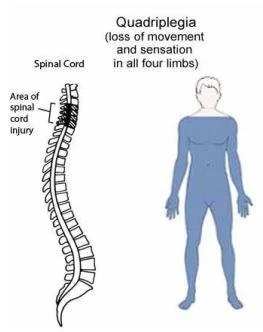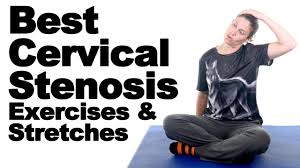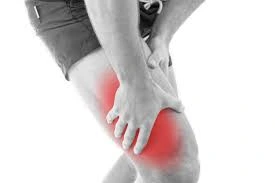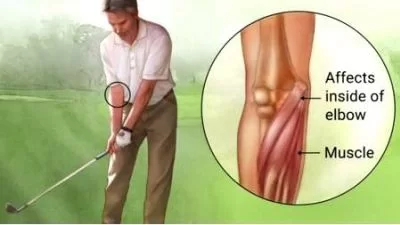Quadriplegia
Quadriplegia is a type of paralysis in which you cannot actively control or move your muscles. It can impact a person from the neck down. Depending on how and why it occurs, it might impair your capacity to move some areas of your body, as well as some of the basic processes that keep you alive.
Quadriplegia is most commonly caused by a spinal cord injury in the neck, however, it can also occur as a result of other disorders. Quadriplegia is occasionally curable, but in most cases — particularly those caused by trauma – the paralysis lasts permanently.
While losing arm and leg function can be severely limiting, identifying the cause of your limb paralysis and being assessed by a qualified neurologist can help you learn about the treatment options available.
In this article Learn more about quadriplegia, including its causes, symptoms, diagnosis, and treatment.
What is Quadriplegia?
- Quadriplegia, also referred to as tetraplegia, is a type of paralysis that affects the torso and all four limbs. The name “quad” originates from the Latin word for “four.”Most persons with tetraplegia have severe paralysis below the neck, and many are entirely immobilized.
- This type of paralysis is mainly caused by injury to the spinal cord, specifically in the cervical spine between C1 and C7. The severity of the injury determines how much damage occurs. Spinal cord injuries to the C1 and C2 vertebrae are frequently deadly because they affect the regulation of breathing and other vital processes.
- You would suppose that total paralysis of the arms and legs involves damage to those limbs, yet most quadriplegics have perfectly healthy (although somewhat atrophied) legs and arms. Instead, the condition frequently starts in the brain or spinal cord (or both). The spinal cord transmits messages to and from the brain, while the brain analyses and transmits new signals via the spinal cord.
- A spinal cord injury causes damage to any region of the spinal cord. It can also cause nerve injury near the end of the spinal cord, known as the cauda equina. The brain and the rest of the body can communicate more easily because of the spinal cord. A spinal cord injury frequently results in persistent alterations in strength, sensation, and other bodily functions below the location of the injury.
- Consider it similar to a computer: the CPU and motherboard are the brains that receive and process signals, while the cables connecting that motherboard to the keyboard, mouse, printer, monitor screen, and so on are the spinal cord’s nerves that connect to various parts of the body. If the cords are severed or damaged significantly, the computer may not function properly. Meanwhile, damage to the CPU may produce similar results.
- People who have had a spinal cord injury may also have psychological, emotional, and social consequences. Many experts believe that breakthroughs in research will eventually allow for the healing of spinal cord damage. Global research investigations are now underway. Many people who suffer from spinal cord injuries can go on to lead independent and productive lives in between treatments thanks to therapy and rehabilitation.
Types of the Quadriplegia
Quadriplegia is classified into two primary kinds based on the degree of completeness:
Complete Quadriplegia:
- Complete Quadriplegia Causes complete paralysis below the neck, affecting all four limbs and the body. Individuals with total quadriplegia lack voluntary muscular control in their arms, legs, chest, and belly.
- They may also have difficulties breathing and need assistance with daily tasks including eating, dressing, and toileting.
Incomplete quadriplegia:
- Incomplete quadriplegia often known as quadriparesis, involves partial paralysis below the neck. Individuals with partial quadriplegia still have some muscular function in their arms, legs, chest, or belly.
The level of residual function varies substantially according to the location and severity of the spinal cord damage. - Some persons with partial quadriplegia may be able to walk with help or utilize adapted gadgets to carry out everyday activities.
Here are some alternative methods to classify quadriplegia:
By muscle tone:
- Spastic quadriplegia: Muscles stiffen and contract involuntarily.
- Flaccid quadriplegia: The muscles are weak and floppy.
By cause:
- Traumatic quadriplegia is caused by a spinal cord injury, such as a vehicle accident or a fall.
- Non-traumatic quadriplegia is caused by an illness or medical condition, such as multiple sclerosis or Guillain-Barré syndrome.
Comparison between Quadriplegia and Tetraplegia
The terms “quadriplegia” and “tetraplegia” refer to the same condition: paralysis below the neck that affects all of the person’s limbs. Differences in ancient languages account for the existence of two words with the same meaning.
These concepts consist of three old root words from two separate languages.
- Quadri-: The underlying term is Latin and means “four.”
- Tetra-: This root word is Greek and signifies “four.”
- -plegia: This root word signifies “paralysis” in Greek.
So, while both terms signify the same condition, “quadriplegia” combines Latin and Greek. Experts generally regard “tetraplegia” as the right name because it does not combine elements of two distinct languages.
How does the location of an issue impact Quadriplegia?
There are various portions to your spine. The cervical spine, often known as the C-spine, is a portion of the neck. Your C-spine comprises seven interlocking bone segments known as vertebrae (“vertebra”). Your C-spine also contains eight spinal nerves, which run between vertebrae and connect to various body parts.
A spinal cord disorder can have a wide range of consequences depending on where it occurs. There are also several definitions for “paralysis.” Some specialists define it as a complete lack of muscular control, while others describe muscle weakening. As a result, some definitions of quadriplegia include limited movement capabilities in the arms or hands.
Medical professionals refer to spinal segments and associated spinal nerves using a letter-number combination. For example, the fifth cervical spinal neuron is commonly known as C5. Quadriplegia can occur with a full or partial spinal cord injury anywhere between C1 and C8. The greater the harm, the more deadly the consequences.
The impacts, depending on location, are the following:
- C1 to C2: Complete paralysis of all four limbs as well as the muscles that regulate respiration. These injuries are nearly invariably fatal without prompt medical attention, particularly breathing assistance (ventilation). Injuries at this level can also disrupt your brain’s link to other elements of your autonomic nervous system, which regulates automatic activities such as sweating, blood pressure management, digestion, and the muscles in your bladder and intestines that you actively relax to urinate or excrete.
- C3 to C4: As above, however injury closer to C4 may not impair your brain’s regulation of breathing muscles. Some breathing difficulties persist, and coughing is significantly impaired, increasing the likelihood of getting pneumonia as a consequence.
- C4-C8: Various degrees of paralysis in your arms and hands. The consequences of paralysis are less prevalent as you move down your spinal cord.
Causes Of The Quadriplegia
Quadriplegia is caused by spinal cord injury in the neck (cervical area). This damage interrupts the brain-body communication system, resulting in loss of muscle control and feeling below the lesion site.
These are some of the most prevalent causes of quadriplegia.
Spinal Cord Injury (SCI):
- Accidents: Auto accidents, falls, sports injuries, and violence are the primary causes of SCI, accounting for around 80% of cases. These injuries can cause spinal cord injury either directly or indirectly by compressing or stretching it.
- Medical condition: Tumors, infections, and certain medical treatments can all damage the spinal cord, resulting in quadriplegia.
- Autoimmune illnesses: Such as multiple sclerosis and Guillain-Barre syndrome can affect the nerves and spinal cord, resulting in paralysis.
Brain Injuries:
- Traumatic Brain Injury (TBI): Severe head trauma can harm the brain stem, which regulates vital activities such as breathing and movement. This can result in quadriplegia, particularly if the damage affects the regions responsible for motor control.
- Stroke: This severe disorder arises when blood flow to the brain or spinal cord is obstructed, causing tissue in the region to hunger for oxygen and finally die. While strokes in the brain often induce weakness on one side of the body, spinal cord strokes in the cervical area can result in paralysis of both arms and legs.
Other causes:
- Birth problems: In rare situations, quadriplegia can be caused by birth disorders affecting the spinal cord or brain development.
- Cerebral palsy: CP is the most common cause of quadriplegia in infants, and it results from a brain injury sustained when the baby is in utero or during labor. This typically results in the limbs becoming floppy or spastic. This can significantly influence a child’s ability to fulfill normal motor milestones and is typically recognized early in life.
- Poisoning: Certain toxins or poisons can harm the neurological system and result in paralysis.
Inherited Conditions That Can Cause Quadriplegia:
Quadriplegia, as well as other types of paralysis, can be caused by certain illnesses or genetic abnormalities. Two conditions can result in quadriplegia:
- Amyotrophic Lateral Sclerosis, or ALS. A well-known condition that leads to lifelong paralysis. As indicated by ALS.org, there are two types of ALS: sporadic and familial. While they acknowledge that sporadic ALS is the most prevalent type of illness (accounting for more than 90% of ALS cases), Familial ALS (FALS) accounts for 5 to 10% of all cases in the United States. The familial type of the illness is inheritable, with each member of the family having a 50% risk of acquiring ALS.
- Muscular Dystrophy. Muscular dystrophy differs from other causes of quadriplegia in that it does not result from nervous system impairment.
- Muscular dystrophy is a group of disorders that cause gradual weakness and loss of muscle volume, Signals continue to reach the muscles and nerves, but as the disorder advances, the muscles lose the strength to respond to those signals. In the early stages, this might result in a loss of capacity to walk, followed by difficulties moving the arms and breathing as various muscles lose bulk and strength. This replicates the consequences of partial quadriplegia while causing no nervous system injury.
Symptoms of Quadriplegia
Here are some of the most prevalent symptoms of quadriplegia:
- Paralysis is the most visible sign of quadriplegia, affecting all four limbs and the body. The degree of paralysis varies according to the severity of the spinal cord damage.
- People with quadriplegia may feel a lack of sensation in the afflicted regions. This might range from numbness to total loss of sensation.
- Spasticity is a condition in which the muscles tighten and stiffen. It might cause pain and make it difficult to move the afflicted limb.
- People with quadriplegia may struggle to regulate their bladder and bowels. Urinary tract infections and other issues may result from this.
It is vital to remember that quadriplegia symptoms differ depending on the individual. Some people may experience all of the symptoms described above, while others may only notice a few. The intensity of the symptoms varies according to the amount of spinal cord damage.
Diagnosis of Quadriplegia
Many individuals are curious about “how to diagnose quadriplegia.” While some may believe that it is simple to detect if you have quadriplegia due to a lack of limb function, certain disorders that cause quadriplegia are not so obvious.
Being able to recognize it early can help you increase your treatment options and improve your overall prognosis by addressing relevant variables. Doctors may utilize multiple approaches to identify the various causes of quadriplegia, such as:
- MRI scans. Doctors can use MRI scans to look for abnormalities in the spinal cord, such as brain tumors, cysts, and herniated discs, that could be interfering with signals from the brain.
- Spinal taps (or lumbar punctures). Doctors may need to extract cerebrospinal fluid from the spinal column to analyze and monitor your spinal health.
- Blood tests. To look for deficits or genetic signs that may suggest that a congenital disease causing paralysis was inherited.
- Electromyography (EMG) tests. Doctors may assess nerve function to distinguish between muscle and nerve problems.
Risk Factors of Quadriplegia
It is vital to highlight that a risk factor differs from a cause in that it may not contribute directly to the development of a certain ailment. A risk factor may merely make a disease (such as quadriplegia) more likely or easier to develop, or it may create situations that enable someone to sustain a quadriplegia-causing injury.
Consider a person falling from a tall ladder to demonstrate the differences between a cause and a danger. On impact, the faller fractures their cervical spine and loses sensation in their arms and legs, becoming quadriplegic. In this case, the quadriplegia was caused by a fall, although being on a tall ladder was the most significant risk factor.
Some risk factors that may contribute to the occurrence of SCIs and TBIs resulting in quadriplegia include:
Gender. Males are more likely to sustain an SCI than females. According to the 2019 NSCISC study, 27,453 males received SCIs from different causes, whereas just 6,672 women did so over the same year. Being male may increase the chance of quadriplegia-causing traumas.
- Age. The age at which the risk of a SCI or TBI is highest has fluctuated throughout time. According to the NSCISC, in the late 1970s, the average “age at injury” (the age of the SCI survivor at the time of injury) was around 28 years old. Between 2015 and 2019, the average age of injury climbed to roughly 43 years old. Also, as people age, they become more vulnerable to severe SCIs and TBIs, particularly if they have osteoporosis or other bone-related diseases.
- Risky behaviors. Diving, driving recklessly (or without seatbelts), and participating in high-contact sports all increase the chance of sustaining a spinal cord or brain damage that results in full-body paralysis.
- Career Options. Certain professions, such as police officers, construction workers, and professional athletes in high-contact sports, are all at a higher risk of injury due to workplace violence or accidents. As a result, they are more likely than the general population to develop quadriplegia.
- Family health history. If you have a family history of ALS (also known as Lou Gehrig’s Disease), you are more likely to acquire the illness and lose control of your arms and legs.
Treatment of Quadriplegia
There is currently no accurate therapy, it will depend on the severity of the damage and the patient’s health. The loss of function and sensitivity in many body areas is addressed.
The primary goal of spinal cord injury treatment is to avoid additional harm and return the patient to an active lifestyle as soon as feasible. Certain treatments may include:
- Respiratory Care
- Skin management and skincare
- Exercises that enhance mobility and strength
- Occupational Therapy
- Bowel and bladder control regimes
There are a variety of therapy options available to assist control symptoms, enhance the quality of life, and encourage independence. These therapies often focus on various subjects:
- Preventing future damage: This may include spinal immobilization, surgery to reduce pressure on the spinal cord, and pain and inflammation management medicines.
- Rehabilitation: Physical therapy, occupational therapy, and speech therapy can help people restore their strength, mobility, and daily life abilities.
- Assistive Devices: Wheelchairs, braces, and other assistive technology can aid people with their movement, communication, and other tasks.
- Managing Secondary Complications Quadriplegia can raise the risk of various health issues, including pressure sores, urinary tract infections, and stiffness. These issues can be treated with medicine, specialized equipment, and continuing medical attention.
Here are some particular therapy options for quadriplegia.
- Physical therapy: It improves muscle strength, coordination, balance, and range of motion.
- Occupational therapy: It helps people restore everyday living abilities including dressing, bathing, and eating.
- Speech therapy: This helps people improve their communication abilities, which may be compromised if the damage is to the neck or upper chest.
- Functional electrical stimulation (FES): it is a technique that employs electrical currents to activate muscles, hence improving mobility and functionality.
- Surgery: In certain situations, surgery may be required to correct spinal injury or to treat consequences such as spasticity.
Researching treatment for quadriplegia
Researchers are continuously investigating new and creative therapies for quadriplegia, such as:
- Stem cell treatment is inserting stem cells into the spinal cord in the hopes of stimulating neuron regeneration.
- Epidural stimulation involves electrical stimulation of the spinal cord, which may enhance mobility and function.
- Exoskeletons: These robotic devices can assist people with quadriplegia in standing, walking, and doing other tasks.
It’s vital to note that the ideal quadriplegia treatment strategy will differ based on the individual’s unique demands and goals. Working with a multidisciplinary team of healthcare experts, including doctors, therapists, and rehabilitation specialists, is essential for creating a personalized treatment plan that supports optimal recovery and quality of life.
Physical therapy for Quadriplegia
Quadriplegia, a kind of paralysis that affects all four limbs and the torso, requires extensive physical therapy for rehabilitation and treatment. It helps quadriplegics increase their movement, strength, independence, and general quality of life.
Here are some of the primary aims of physical therapy for quadriplegia.
- Maintain and enhance your range of motion (ROM). This helps to prevent contractures, which are muscle shortening and tightening that restrict joint movement. Passive ROM exercises, in which a therapist moves the joints for the client, are frequently employed first. Active range of motion exercises can be gradually introduced as the individual’s strength increases.
- Increase muscular strength: Strengthening exercises increase muscular function and control, which can be useful in tasks like transfers, dressing, and self-care. Depending on the individual’s injury severity and goals, many forms of strengthening exercises may be employed.
- Improve balance and coordination: This can assist people with quadriplegia to stay upright and avoid falls. Balance and coordination exercises might be difficult, but they are essential for increasing independence and safety.
- Improve functional skills: Physical therapists can assist patients with quadriplegia in learning or relearning how to conduct everyday tasks such as transferring from bed to chair, dressing, and using the restroom. This can be accomplished using several ways, including task breakdown, assistive technology, and compensatory tactics.
- Managing pain and spasticity: Pain and stiffness are frequent issues following a spinal cord injury, and they can interfere with physical rehabilitation and daily activities. Physical therapists can utilize a range of approaches to alleviate these symptoms, including massage, electrical stimulation, and therapeutic exercise.
Physical therapy treatments for quadriplegia might differ based on the individual’s. The degree of damage dictates which parts of the body are affected and the amount of paralysis.
Individuals with high general health and fitness may be able to engage in more difficult physical therapy activities. Set reasonable and achievable objectives for physical therapy. These goals should be tailored to the individual’s level of injury, hobbies, and lifestyle.
Here are some extra points to remember regarding physical therapy for quadriplegia:
- Physical treatment is a lifelong commitment. Most quadriplegics will need to undergo physical treatment regularly to preserve their development and avoid problems.
- It is critical to identify a physical therapist who has prior experience dealing with people who have had spinal cord injuries.
- Communication is essential. It is critical to talk with your physical therapist about your objectives, concerns, and any discomfort you are feeling.
Adverse Effects of Quadriplegia
Aside from the primary symptoms of quadriplegia stated previously, quadriplegics may experience a variety of other adverse effects induced by the disease. Some frequent consequences of tetraplegia/quadriplegia are:
- Bed Sores. Sores can develop when a person is unable to shift or modify their position in a seat or bed for an extended length of time. Secondary infections may result from this in addition.
- Spastic limbs. Some quadriplegics may get uncontrollable muscular spasms in their arms or legs. This might be the result of partial nerve injury or another disorder that causes quadriplegia.
- Urinary Tract Infections (UTI). Quadriplegia is associated with a high incidence of urinary tract infections. The lack of bladder control makes it harder to discharge pollutants from the urethra, which can lead to infections.
- Muscular atrophy. Because of their inability to move, quadriplegics frequently lose muscle mass in their arms and legs, a condition known as muscular atrophy. Exercise and physical therapy can help to reduce this quadriplegia side effect.
- Chronic pain. SCI and TBI sufferers frequently experience pain as a result of disrupted nerve connections. However, the degree of discomfort felt by each individual differs, making it difficult to generalize about this adverse effect.
- Difficulty with Body Awareness. A lack of feeling might naturally result in an inability to determine where one’s limbs are at any moment. This may interfere with spatial cognition.
- Weight gain. Quadriplegics who cannot exercise or move may acquire weight quickly due to their inability to burn calories.
- Respiratory infections. Respiratory infections are a significant cause of death among new quadriplegics in the first few months after their injury.
- Loss of Fertility or Sexual Function. Men may struggle to get an erection and ejaculate, but women may have trouble lubricating. Quadriplegics of either gender may have trouble obtaining orgasm or notice changes in their libido following an accident.
Living with Quadriplegia
- Living with quadriplegia may be a huge struggle, requiring both the quadriplegic and those around them to make considerable lifestyle changes.
- Quadriplegics, who lack control over their arms and legs, frequently rely on helpers to go around, use the restroom, eat, and perform other everyday tasks. Some motorized wheelchairs can be controlled by quadriplegics using head gestures, however, it may take some time to adjust.
- As a result of their illness, quadriplegics will suffer major changes in their everyday activities, as well as in their life expectancy.
Prevention for Quadriplegia
The most prevalent cause of quadriplegia (trauma) is frequently avoidable. The greatest ways to avoid spinal injury and trauma are:
- Wear safety equipment. Safety restraints (such as seat belts) should be utilized wherever possible. Quadriplegia can be avoided with the use of seat belts and other restraints. People who participate in sports should always use the appropriate protective equipment. Helmets and padding are crucial when playing appropriately and safely. That includes avoiding tackling or striking from behind in contact sports like football and hockey.
- Take care to prevent falls. When working on a roof or any high location, always use safety equipment, particularly safety harnesses. You should also take precautions to prevent falls in the home, particularly on stairs or in restrooms. This includes adding handrails, utilizing non-slip footwear and floor surfaces, and maintaining steps free of tripping hazards.
- Use caution when handling weapons. Gunshot wounds are among the most common forms of spinal cord injuries that result in paraplegia. No matter what, you should always handle firearms with the best caution. Even if you know they aren’t loaded, act as though they are. Guns should also be kept out of children’s reach, unloaded, and locked with a trigger lock. Weapons should be kept separate and secured under lock and key.
- Avoid abusing alcohol, recreational drugs, or prescription pharmaceuticals. Your immune system’s capacity to combat infection may be impacted by these. They may also raise your chance of becoming hurt in accidents like car wrecks and falls.
FAQs
What is quadriparesis?
Quadriparesis is a muscular weakening that affects all four limbs. Also known as tetraparesis, this weakness and reduced movement might be transient or permanent.
Is there a therapy for quadriplegia?
Non-surgical treatment options for quadriplegia include physical therapy, occupational therapy, speech/language therapy, muscular spasm medicines, and the use of medical equipment.
Is touch sensed by quadriplegics?
Certain individuals who are quadriplegics are capable of feeling things on their skin. The feelings could come on suddenly or continuously.
Can quadriplegia cause you to heal completely?
Quadriplegia can sometimes be treated temporarily or even completely, however these are often rare. This is most frequently the case when the issue is with spinal cord disturbances that do not cause long-term harm or alter the structure of your spinal cord.
Are quadriplegics ever able to walk again?
Some elements—like the kind and extent of the injury—cannot be altered, but others—like motivation, diet, and involvement in rehabilitative therapy—can have a big impact on healing. Many people who have had spinal cord injuries can walk again with perseverance and an optimistic outlook.
References
- Professional, C. C. M. (n.d.). Quadriplegia. Cleveland Clinic. https://my.clevelandclinic.org/health/symptoms/23974-quadriplegia-tetraplegia
- Spinal cord injury – Symptoms and causes – Mayo Clinic. (2023, October 12). Mayo Clinic. https://www.mayoclinic.org/diseases-conditions/spinal-cord-injury/symptoms-causes/syc-20377890
- Quadriplegia: what is it, symptoms and treatment | Top Doctors. (2023, March 22). Top Doctors. https://www.topdoctors.co.uk/medical-dictionary/quadriplegia
- Spinalcord.com. (2020b, December 22). Quadriplegia & tetraplegia: Definition, causes, symptoms, and treatment. https://www.spinalcord.com/quadriplegia-tetraplegia
- Quadriplegia: causes, risk factors, symptoms, treatment. (n.d.). https://continentalhospitals.com/diseases/quadriplegia/







